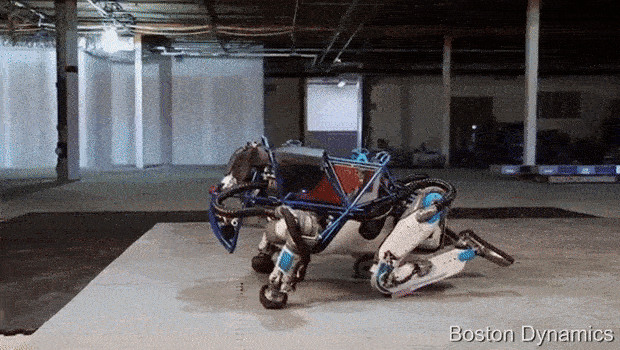Boston Dynamics' robots — impressive, but far from the Terminator
For these robots, there remains a discrepancy between staged demonstrations and real world performance

Image credit: From Bosyon Dynamics
What Happened
In March of 2019, Boston Dynamics released yet another amazing video showcasing the box stacking capabilities of their whegged (wheel-legged) robot. The robot zooms around a warehouse, picking up and placing objects on its two wheels.
Boston Dynamics is back at it. You've seen their robots do backflips, run, and even open doors, but now the company is ready for heavy lifting with this box-stacking bot. pic.twitter.com/FeTp9BAnAK
— WIRED (@WIRED) March 28, 2019
As Wired put it, this represents Boston Dynamics being “back at it”, with ‘it’ referring to their periodic release of videos showcasing their robots’ performing amazing feats. The previous such video came out in October 2018 and showcased the parkour skills of their humanoid robot Atlas. The robot can be seen soaring over logs and leaping onto platforms – actions which require extreme energy and strength for a hefty robot to perform (Atlas weighs up to 150kg). Nevertheless, the video shows Atlas navigating these terrains with remarkable ease:
The robots are evolving, and they can do parkour now. Boston Dynamics recently released a video showcasing its humanoid "Atlas" robot leaping over obstacles and lifting objects. https://t.co/pdjaic9sKT pic.twitter.com/SC9Rb1CfYk
— CNBC (@CNBC) November 25, 2018
Marc Raibert, former Carnegie Mellon and MIT professor and director of the Leg Lab, developed the first self-balancing hopping robots. In 1992, he went on to found Boston Dynamics. Since then, you may have heard of them through many of their other projects. Some favorites include BigDog, capable of traversing rough terrains; SandFlea, which stores enough energy to jump onto buildings; SpotMini, which brings smooth moves to the dance floor; and Atlas, the humanoid robot that can drive its own vehicle.
In particular, Atlas has demonstrated many impressive actions throughout the years. Its capabilities include backflips, opening and holding doors, washing dishes, trail running, and lifting boxes, and more:



The Reactions
Atlas initially triggered a dystopian response from viewers and media alike. Many of these headlines appear to be in jest. However, there also seems to be serious concern from some viewers about the true implications of Atlas’ current capabilities, and some of the following don’t help:
-
Fast Company greeted the new warehouse robot with the headline “Those frightening Boston Dynamics robots will also take your warehouse job”.
-
The Telegraph published a summary of Atlas’ backflip video calling the robot a “terrifying humanoid.”
-
At the time of the reveal of the original Handle robot, The Inquierer called it a new robot nightmare.
Many of the “humorous” headlines referenced the pop-culture concept of a “robot uprising.”
-
Gizmodo warned of a “shockingly nimble” robot uprising.
-
MarketWatch advised readers to “not bother running away.”
-
Mashable has a top 5 of “times Boston Dynamics robots scared the hell out of us”.
This, in turn, has led to some concerns about misunderstandings that may arise from Boston Dynamics’ strategy of releasing these videos without much further explanation:
- Researchers and other experts are more worried about people’s raised expectations about what robots really can do than by the robots themselves. NVIDIA’s director of research describes her experiences with the general public, stating that many believe the Boston Dynamics dogs are more intelligent than real dogs.
In my broad audience talk, I usually ask which one is more intelligent: a dog or a @BostonDynamics robot. You will be surprised how many people think it is the latter. General public has a flawed understanding of intelligence and #AI #mediahype is not helping
— Anima Anandkumar (@AnimaAnandkumar) January 26, 2019
- Filip Piekniewski, an AI researcher, likewise expressed that the videos do not mean that Boston Dynamics’ robots are anywhere near as intelligent as dogs:
They are absolutely amazing mechanics and balancing. But they lack any high level cognition. All these videos a precisely staged. BD is specializing in great bodies, but not in brains for these bodies.
— Filip Piekniewski (@filippie509) October 29, 2018
- Jack clark, a journalist, stated that Boston Dynamics’ press strategy was simply to release videos and avoid any questions from the press:
Former journalist here - Boston Dynamics main press strategy for many years was to publish videos and never give interviews or respond to technical questions, so they never tried to help media add more info/context. : (
— Jack Clark (@jackclarkSF) October 14, 2018
It’s hard to get a sense for the general public’s perception of the videos, but just sampling several tweets shows some are genuinly concerned about the ‘robot apocalypse’ scenario:
Are we all so blind that we can’t see that Boston Dynamics is the real world Skynet that is creating robots and dogs that will destroy all humans and then drink tea in our couches? Wtf is wrong with everyone?
— Pauly (@Pauly_Riordan) January 27, 2019
Boston dynamics, this is creepy and scary. Put Alexa and AlphaZero in there we have skynet...scaaaary... https://t.co/QAW2sfuS9i
— Suki Wang 👄王小可 (@sukiwanglaw) April 8, 2019
So has anyone on the Boston Dynamics team ever watch any of the Terminator movies? Do they watch black mirror? CASSIE???
— THE CINEMATIC HITMAN (@CinematicHitman) October 15, 2018
i'm not afraid of technology but honestly we all know this is going to be the end of humanity once these things can build themselves. https://t.co/BnLVScJFg6
They finally figured it out...run & jump with one leg smoothly to climb...be afraid. I many others, prominent physicist Steven Hawking, for years have warned abt autonomous robots. Especially meant to b troops 1 day. Boston Dynamics govt contracted https://t.co/cLjlplQsB5
— RURdy4It (@RURdy4It_) October 12, 2018
Of course, these represent outliers in the public opinion. Still, reactions along the lines of ‘impressive, but also vaguelly offputting’ are common whenever new Boston Dynamics videos come out:
Amazing (and slightly scary) new humanoid robot from Boston Dynamics https://t.co/YR7tnxXCsW
— Chris Dixon (@cdixon) February 24, 2016
I am so conflicted in emotions when I see these robots from Boston Dynamics. It's impressive and scary at the same time. #Science https://t.co/LtsSDUDWeH
— Chiké Verwey (@GuyaneseCV) April 1, 2019
I know this is fantastic science... but there is also something really scary about this. https://t.co/6u1ekQS7zh
— BROOKS HOFFOS (@BrooksHoffos) April 1, 2019
Scary...but also pretty cool. https://t.co/2AMH7ErTOB
— Dave Seibert (@littlesigh) March 30, 2019
Believing that these videos represent robotics with advanced autonomous capability is problematic, since that is far from the truth. There are substantial differences between a robot that autonomously performs these actions versus one that is preprogrammed to do so with the help of external sensors and computation, and the lack of transparency makes it unclear what Atlas and friends are capable of. Though the details are not clear, it appears to be the case that Boston Dynamics’ technology does not involve learning or advanced cognition and is based on human-defined methods for robotic control:
Boston Dynamics are getting a lot of press these days, but perhaps their most impressive accomplishment is that they do it all without any deep learning.
— James Ough (@james_ough) November 10, 2018
Here's the math behind Atlas, the backflipping humanoid.https://t.co/5l7VZ0MBzs … … pic.twitter.com/8IOTWuDqxF
Fortunately, multiple articles have tackled the subject of Boston Dynamics videos. A Wired article does a good job explaining how to watch and interpret Boston Dynamic’s: focus on the large margins of error (there’s always a chance in the demos that things can go wrong, but what you’re seeing is the successful trial), partial autonomy (the systems don’t operate entirely on their own and require human guidance or pre-determined instructions), and our human instinct to anthropomorphize and connect to biological systems (humans tend to see the dog- and human-looking robots and assume many advanced capabilities that the biological versions already have, such as perception and emotion). Additional articles tackling the subject include Boston Dynamics’ scary robot videos: Are they for real?, Why Boston Dynamics’ backflipping borg shouldn’t scare you, You’re Expecting Too Much Out of Boston Dynamics’ Robots, and The Fantasy Robots Of Boston Dynamics. As the last piece states:
“The achievements of Boston Dynamics in robot movement on two and four legs are undeniable and sometimes breathtaking. That’s where its real contribution lies. But its videos play on widespread, potentially dangerous fantasies of autonomous robotic armies without human casualties (on our side, that is), old people left in the care of machines, and a near future when robots do all the work. It’s high time we freed ourselves from the techno-marketing hype and began to see AI and robotics for the fascinating, although limited, developments they really are.”
Our Perspective
Alongside their video, Boston Dynamics released a caption with their video, stating:
Handle is a mobile manipulation robot designed for logistics. Handle autonomously performs mixed SKU pallet building and depalletizing after initialization and localizing against the pallets. The on-board vision system on Handle tracks the marked pallets for navigation and finds individual boxes for grasping and placing.
When Handle places a boxes onto a pallet, it uses force control to nestle each box up against its neighbors. The boxes used in the video weigh about 5 Kg (11 lbs), but the robot is designed to handle boxes up to (15 Kg) (33 lb). This version of Handle works with pallets that are 1.2 m deep and 1.7 m tall (48 inches deep and 68 inches tall).
While it’s nice to see this description being released alongside their video, it would be helpful if Boston Dynamics would reveal more about their methods. The about page of their website does not contain more details, and their robot-specific pages explain slightly more but do little to dispell misunderstanding. The lack of concrete details is in part responsible for the rampant speculation online, and in fact the company seems to provoke and enjoy the speculation by posting viral, vague videos. This helps to create interest around Boston Dynamics’ projects, and their incentives to be as opaque as possible are almost understandable: secrecy insures that competitors cannot copy their achievements, strikes the public’s imagination, and leaves everyone in the dark about the weaknesses of their technology. Yet the dearth of information is not all benefits: it creates unrealistic expectations for real world performance of the robots, and provokes the ire of less naive observers.
An article on the potential dark future of AI spells out the parallels of SpotMini from Boston Dynamics to a Black Mirror episode containing weaponized guard dogs that look a little too similar for comfort and more importantly goes into detail about what exactly people fear. The list includes aspects such as the incomprehensible, black-box decision-making process of robots, particularly when it comes to significant decisions that may infringe upon international human rights law and international policing standards. While Boston Dynamics does not explicitly make any egregious claims on how advanced their technology is (unlike Sophia), their non-transparency does not help assuage these fears.
These threads and discussions prompt some of the same questions that we came up with while watching the videos:
-
Are the actions and motions pre-programmed? Does the sequence of the obstacles impact performance?
-
Are Atlas’s decision-making process and motion planning occurring in real-time?
-
Is the computation being done on-board? How much information is embedded within the visual markers?
-
How much information does Atlas have about its environment? What knowledge is transferable to other environments?
Many of these questions represent open challenges in robotics and autonomy; some transparency would be helpful to better gauge which problems Boston Dynamics has solved. In addition, there is a gap between systems that can perform a few of these individual tasks in structured environments and those that can autonomously navigate in unstructured terrain. To be fair, what Boston Dynamics has accomplished is still very impressive. Their robots are capable of many extremely dynamic tasks and appear to be incredibly robust to disturbances in their environment. However, transparency would help both researchers and general public alike to better understand which features are realistic and which are fantasy.
In addition, there is genuine concern from the general public and researchers alike about the use of robots as autonomous war weapons. Boston Dynamics makes no secret of their interest for military applications, and the misguided headlines about a “robot uprising” against humans obfuscate the more mundane prospect of humans killing other humans with more ease than ever, using robots.
TLDR
Atlas is a fantastic case study of a robot that demonstrates the significance of distinguishing between one-off demonstrations and generalizable techniques that are usable in various contexts. The physics and mechanics of each capability are incredibly impressive, but we are very far from the cries of a robot uprising. For comparison, trickshot specialists produce jaw-dropping highlight reels, but their skills don’t always translate directly to the level of professional athletes who must seamlessly weave multiple skills together simultaneously. Real-world environments are very complex, and systems need to be robust to uncertainty in their environments.









